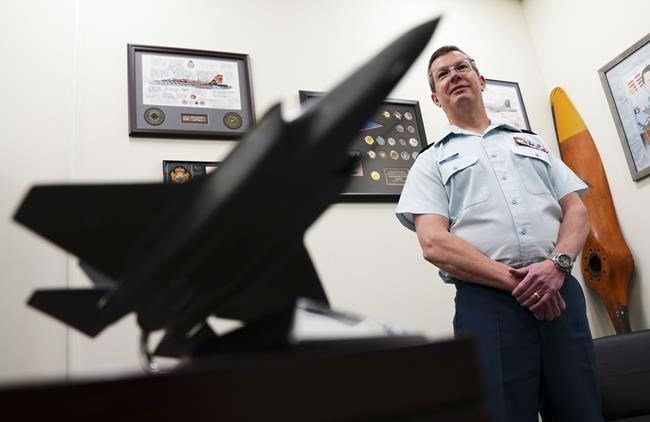OTTAWA — A model F-35 sits in a place of prominence on the corner of Lt.-Gen. Eric Kenny's desk. The miniature grey aircraft is propped in the air by a plastic stand as if it is flying, and Royal Canadian Air Force markings are visible on its wings.
Displaying such a model inside National Defence Headquarters, let alone on the desk of Canada's Air Force commander, was strictly verboten before the Trudeau government officially committed to buying the plane last month.
With the decision made, Kenny is now able to do more than display a model on his desk. He can also speak openly about the Air Force's plan to transition from its aging CF-18s to the F-35, part of what he describes as a larger leap into a new age for the organization.
"It's an exciting time," he said in an interview. "The F-35 is going to not only bring us into being a fifth-generation Air Force, it's really going to change how the Department of Defence looks at security and data and information, and what we do with that data."
Between plans to buy armed drones, launch satellites and upgrade North America's early warning system, the F-35 is just one of several high-tech additions that Kenny suggests will firmly entrench the Air Force in the 21st century over the next decade.
"The Air Force of 2035 is going to look completely different than the Air Force in 2023," he said. "The amount of projects that are going through right now is similar to what we saw in the late '70s and early '80s."
Yet while Kenny and his staff have developed a carefully choreographed plan to make the transition as seamless as possible without putting the country at risk over the next decade, it isn't without its risks.
That starts with a shortage of personnel.
Like the rest of the Canadian Armed Forces, the Air Force is struggling to recruit and retain enough people to fill its ranks. Kenny revealed the Air Force is short nearly 2,000 full-time members and 500 reservists, at a time when it is supposed to be expanding.
"And we expect the gap to become bigger up until 2025, assuming we achieve our recruitment numbers," he said.
Those personnel shortages are expected to put pressure on the Air Force as it tries to co-ordinate, for example, the training of personnel for the F-35 while having enough pilots, mechanics and other members to continue flying the CF-18 until the transition is completed.
"All this only works if we have people," he said. "So I have to balance the people piece, not only of today, but of the future."
The successful arrival of the first F-35 on Canadian soil by 2029 will also require significant upgrades to the Air Force's aging hangars and maintenance facilities at its main fighter bases in Bagotville, Que., and Cold Lake, Alta., as well as the military's computer networks.
"What we need to do is have enough time to have all the infrastructure in place, the security in place, the (information technology) backbone, so that when the F-35 comes to Canada, we actually have capability," he said.
Plans to modernize the North American Aerospace Defence Command, or Norad, which is responsible for guarding the continent against airborne attack, will also require significant investments in sensors and control centres over the next decades — including in the Arctic.
Yet Ottawa's record on military infrastructure is extremely mixed, particularly in the Far North. The Defence Department recently confirmed delays in upgrading and rebuilding two jetties in Esquimalt, B.C., and a new armoury in New Brunswick.
All of that is in addition to constant delays in procuring new military equipment — and problems when that equipment is finally delivered, which the Air Force has seen first-hand with its new Kingfisher search-and-rescue planes and Cyclone helicopters.
The Kingfishers were an example of how a carefully laid plan by the Air Force got derailed by delays, with Kenny having to reassign transport planes and air-to-air refuellers to save Canadians in distress while waiting for the new planes to be ready.
Acknowledging the challenges, Kenny said he will do what he can to ensure a smooth transition for the Air Force into the future — a transition he says is critical as adversaries develop new weapons and flex their muscles in new and worrying ways.
"There's always so much complexity with each of these projects, and there's possibilities that certain things will be later than others and therefore there'll be a ripple effect," he said.
"I'm going to do whatever I can to make sure we deliver as fast as we can. Because if we don't, then I think we're at risk of not being able to meet the future security threats that are coming."
This report by The Canadian Press was first published Feb. 13, 2023.
Lee Berthiaume, The Canadian Press



